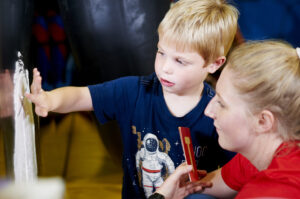Total Communication

A Total Communication approach moves the focus away from a reliance on spoken language and emphasises the importance of other forms of communication as an alternative to speech. Using a Total Communication approach can help children with learning and communication difficulties to develop their understanding and expression in order to communicate more effectively.
Total Communication is a holistic view of communication that can be used with children, adolescents and adults. It involves not only oral language to build communication skills, but introduces gestures, sign language, and other visual communication systems. Speech and Language Therapists can work with parents to create a system of communication that works best for their child. This may include introducing sign language to pair with verbal words, using visual aids to facilitate comprehension or the introduction of an augmentative device.
Research supports that teaching speech and other modalities of communication together can increase the likelihood that a child will speak. This is because talking or using sign language actually activates the same area of the brain responsible for communication. There is no evidence to support that using other methods of communication, such as sign language, will discourage the use of speech.
We all communicate in different ways and each way should be equally respected and encouraged. Non-verbal communication can be just as effective as speech. The important thing to remember is that communication is a two-way relationship and it will only be successful if the communicator and the people who they are communicating with are using the same language, i.e. there must be a shared communication system. Sometimes a child’s way of communicating may be subtle and hard to recognise. It is very important that you spend time getting to know what method or combination of methods works best for your child in order to maximise communication and prevent communication breakdowns.
Total Communication is an approach which includes all the ways in which we communicate including:
- Eye contact – Facial Expression
- Body Language – Vocalisations
- Speech – Symbols
- Photos – Writing/Drawing
- Objects – Signs and Gestures –
Your Speech and Language Therapist can work with you and the school setting to develop the most effective communication system for your child and to provide advice in relation to maximising communication by using every available means.
Written By
Sarah Gorman, Senior Speech & Language Therapist at Sensational Kids, Kildare
Copyright Sensational Kids CLG 2018

